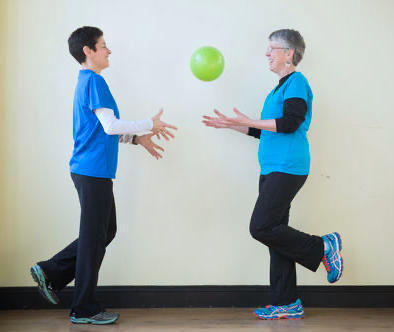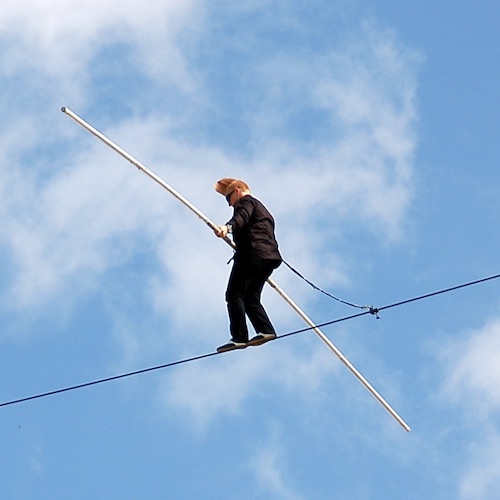People often tell me with great pride how they work on their balance by standing on one leg while brushing their teeth. I appreciate that they’re working a healthy habit into their daily lives, and this habit is better than having no balance practice at all.
But it misses something important about how and why we need better balance.
The way we need our balance is to prevent a fall that is likely to happen while we are in motion, such as walking on uneven surfaces (on a hike or cobblestone road), walking with an active pet who suddenly crosses in front of you or navigating a busy airport or crowded market.
So, unless you have a partner trying to push you over while brushing your teeth (which I am NOT recommending!), you’re probably not getting as much balance challenge as you need to prevent a fall.
The way we build a skill for any activity is by re-creating the conditions of the activity.
To get on-balance, you must first get off-balance
If you want to get better at hiking up a steep mountain, you’ll train by walking on inclines. If you want to get better at lifting your growing grandchildren, you might start lifting heavier weights, walking around with them and then handing them back to someone else (that last one is a little joke).
When it comes to improving balance, we need to test ourselves with intentionally unstable (but safe) environments. This is how we improve our stability for the situations in which we need it.

Balance is multi-faceted
Balance is influenced by many factors, some of which you might not even realize. Vision, medications, sleep and joint injuries are a few that might not be the first things that come to mind. Yet it’s important to be aware so you can take these things into consideration when deciding what activities are best for you at any given time.
Nevertheless, any amount of functional balance training you do is going to reduce your risk of a falling accident, even in the presence of other risk factors.
So what’s functional balance training?
Practice for real-life events, so your body is prepared to handle them.
One of my clients recently showed me how she plants her feet in a particular position to resist the jerky movements of the D.C.-area metro train stopping and starting. As a very active 79-year-old, she came up with this herself. It just so happens the position she showed me is one we often use when training balance.
In addition to placing your feet in positions or on surfaces they’re not accustomed to, we introduce other components that are known to challenge balance: re-directing your vision, having you move objects around while in an unsteady position, challenging you to take a rapid step in an unexpected direction or resist a wobbly object (like a resistance band).
The idea is to perform these de-stabilizing things in a safe, controlled environment, so that when you’re in an uncontrolled environment – out in the world – your body “knows” the automatic reactions it needs to stay upright.
What can you do?
A few organizations, such as A Matter of Balance and the Otago Exercise Program, have created structured programs offered throughout the country. Whether these classes are right for you depends on your current status. Research has shown they are MOST helpful to folks over 80 or at high risk of falling, though they are designed for anyone over 60.
A fairly mobile person who wants to feel more stable while remaining active may need a greater level of challenge. If that’s you, feel free to be in touch for some ideas.


